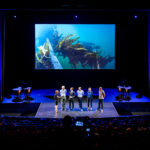
By definition, almost everything about convention centers is built on a very large scale. Designed for thousands of meeting attendees, they also hold vast expanses of blank walls, acres of public space, and soaring atriums. At one time, filling up some of that empty space with attractive art might have been as ambitious as many convention centers were likely to get.
But that has changed in recent years, as centers have expanded and elevated art programs beyond mere decoration or even the goal of building world-class collections. In many cases, the artwork is part of a larger trend to link convention centers more closely — physically and symbolically – with the destinations where they’re located. The art may impress visitors, but the intention is interaction and engagement.

CREATIVE SHOWCASE
At Music City Center in downtown Nashville, creating an art collection that would bring local residents together was an explicit goal of Mayor Karl Dean, according to Rich Boyd, who serves as the center’s art consultant. Dean “wanted the facility to be more than a place for conventions,” Boyd said, “but to serve as Nashville’s front porch.”
Music City Center opened this past May with a collection of 103 works of art, eight of which are large-scale, site-specific pieces commissioned for the architecturally innovative center — which you might argue is a work of art in itself. Much of the artwork, like the guitar-shaped outline on the building’s roof, draws on Nashville’s musical heritage. But the center’s collection also is imbued with contemporary energy and local flavor — 43 of the artists are regional.
“What we wanted to do was, not just fill space with decoration, but showcase the creative vitality that resides within the middle Tennessee region,” Boyd said. “The visual arts are exploding in Nashville. We are identified with music — and we take that identification proudly — [but] the visual arts and the number of galleries opening is just astounding.”
In Boston, where the Massachusetts Convention Center Authority (MCCA) has operated a community art program since the mid-1990s, the opening of the Boston Convention and Exhibition Center (BCEC), with more than a half-million square feet of space, in 2004 was a turning point, said Susan Merritt, a consultant who runs MCCAs art program. “The sheer expanse [of space] was so much greater than at [Boston’s Hynes Convention Center],” said Merritt, a former art museum curator. MCCA Executive Director James Rooney “used the opportunity to expand the art program tenfold,” Merritt said, “in terms of art and quality.”
When Rooney first contacted Merritt, she had anticipated that MCCA was interested in purchasing art for a collection at the BCEC. Instead, Rooney had a different vision -— of art continually moving through the BCEC and the Hynes, keeping the visitor experience fresh. In addition to exhibiting some permanent pieces, MCCA secures one-to-three-year loans for large-scale works, including sculpture, from galleries or directly from artists. Additional artwork at the centers comes from Boston-area artists — the MCCA works with the Mayor’s Office of Arts, Tourism & Special Events to install exhibits lasting for about three to four months each, showcasing local work from professional and student artists. The exhibits represent “a melting pot of mediums,” Merritt said.
The art offers visible proof that Boston is not “an old, tired, provincial city, or even just a center for technology and education,” Merritt said, “ but a hotbed of artistic activity.” The “art reflects community,” Rooney said. “By supporting the local arts community, we feel we support the vibrancy and uniqueness of Boston and its diverse neighborhoods.”
The MCCAs art program “also brings the community into our facilities, showing them the work and the benefit of what we do,” Rooney said. “Without it, we’d just be another convention center.”

‘OBSERVE AND APPRECIATE’
It’s not just convention centers that are turning to local art as a way to communicate a sense of place. Hotels of all sizes are installing works inspired by local culture and history and created by regional artists. The 1,001-room Omni Dallas Hotel features more than 7,000 pieces of artwork from Dallas-based artists, while the 157-room Alexander in downtown Indianapolis holds more than 50 works, including site-specific commissioned pieces, many of them based on Indiana personalities or culture.
Education is an important component of many art programs at hotels and convention centers. In Nashville, local schools are developing curriculums based on Music City Center’s art. “There is documentation that when children are exposed to art as part of a curriculum,” Boyd said, “they test higher in every subject, including math and science.” There’s value to adult learners as well, he added. Meeting attendees, who are stepping out of their typical environments, are ripe for making creative connections, or for learning something new about a different culture.
Convention center art programs don’t mistake themselves for museum programs, Boyd said. For one thing, while subject matter can be thought-provoking, it is seldom provocative. “It’s not all sailboats and gardens,” Merritt said, but the exhibited work generally steers clear of overtly political, sexual, or religious themes.
“Public art has to be more accessible,” said Mark Ernst, an architect at Engberg Anderson in Milwaukee, which was a lead in a project to integrate the work of 14 artists and 15 writers into the Wisconsin Center (formerly Midwest Airlines Center) when it was constructed in 1998. It “isn’t usually dark and murky and moody,” Ernst said, “and often injects levity and surprise.”
The scope and purpose of MCCA’s art program, Merritt said, “is for people to stop and observe and appreciate.” By her estimate, only one in 100 people pauses to look closely at each of the individual artworks installed at the Hynes and the BCEC. Considering that the centers will draw 770,000 visitors through their doors this year, “that’s a pretty good ratio,” she said. (In comparison, New York City’s Metropolitan Museum of Art had 6.3 milllion visitors in 2012.)
And if convention centers are an unconventional, unexpected place for art, Merritt said, “I think that’s a good thing” — bringing something to the public that they otherwise might not come into contact with. Some visitors, including the mainstream sports fans who come to the BCEC, might be intimidated to walk into Boston’s Museum of Fine Arts. “At the convention center,” Merritt said, “they can see really fantastic art — without feeling they need a Ph.D. in art history.”
On the following pages you’ll find a selection of artwork that was installed in convention centers and conference hotels around the world in the last five years.

SAN JOSE MCENERY CONVENTION CENTER
A renovation completed last month at the San Jose McEnery Convention Center included the installation of Soo-in Yang’s Idea Tree sculpture in front, where it serves as a gateway to the expanded facility.
With the sculpture, city and convention center officials were looking for a way to broaden the function of art at the center, according to Jennifer Easton, program lead for the city’s public art program. The goal was to create a dynamic, engaging experience for residents and visitors, while also communicating the spirit of San Jose, the capital of high-tech Silicon Valley. “High tech,” Easton said, “is really about the notion of innovation.”
The central element of Idea Tree is a canopy, 40 feet in diameter, covered with polycarbonate leaves, which during the day will provide shade in sunny San Jose and at night will light up with pulsing colors. The sculpture includes an adjacent “sound booth” where visitors can leave short voice messages — leaving traces of themselves behind — that will be mixed and reassembled to create a soundscape that’s audible to people who are standing beneath the sculpture. Yang himself describes it as an “ecology of ideas” — something that could be said about meetings and conferences themselves.
Like many of San Jose’s best-known exports, Idea Tree is a technological feat, but as Yang told the panel of experts who commissioned the work, the first requirement for the sculpture was that it be “must-see and magical.”

THE ALEXANDER, INDIANAPOLIS
The collection of public art installed at The Alexander in downtown Indianapolis — more than 50 works by more than 25 contemporary artists, including 14 site-specific commissions — has impeccable credentials. Curated by the Indianapolis Museum of Art, The Alexander’s art program includes the work of both regional and international artists, including Jorge Pardo, a recipient of a MacArthur Genius Grant.
But it doesn’t take itself too seriously. “It’s meant to be accessible,” said Marcus Barlow, a spokesman for The Alexander.
The murals installed in the parking garage, by British graffiti artist Nick Walker, are sometimes mistaken for the work of a very talented vandal, Barlow said. Other lighthearted works on the hotel’s second-floor meeting-room level include a large-scale portrait of America’s first female self-made millionaire, C.J. Walker, who once operated a beauty-products empire in Indianapolis, constructed from 3,840 black plastic hair combs. Another piece, Anthem, features vinyl records — including some by Indiana musicians — heated and reshaped into a flock of vinyl birds.
OMNI NASHVILLE HOTEL
What says “vintage Nashville” better than a rhinestone cowboy? In creating artwork that draws on Music City culture for the Omni Nashville Hotel, artist Dolan Geiman was inspired by the work of the late Nudie Cohn, creator of the famously flashy “Nudie Suits” — intricately patterned and bejeweled stage outfits worn by such Nashville-based musicians as Dolly Parton and Porter Wagoner, and scores more country-western icons.
Geiman translated the rhinestone and embroidery using wood cutouts and found objects salvaged from abandoned barns and old hotels. Five of Geiman’s Nudie-inspired works hang in the Omni Nashville, which opened on Sept. 30, directly adjacent to Music City Center. Tennessee-based artists created more than half of the property’s artwork.
VANCOUVER CONVENTION CENTRE
Since its installation at the Jack Poole Plaza overlooking the harbor at the Vancouver Convention Centre in 2010, the large-scale “pixelated” orca whale has become one of the city’s best-loved photo opps. Created by Douglas Coupland, a Vancouver resident and author of the 1991 novel Generation X, the sculpture is part of an art program tied to the Vancouver Convention Centre West expansion project that included major works commissioned from both British Columbia artists and international artists.

Drift Artist: Anthony Gormley Hotel Tower 1 Atrium Installed: 2010
MARINA BAY SANDS, SINGAPORE
Everything about the Marina Bay Sands resort in Singapore is on a grand scale: its 2,561-room hotel, its 1.3-million-square-foot convention center, and its $8-billion price tag. That includes the resort’s unique Art Path, consisting of 11 large-scale installations contributed by seven international artists. Weaving throughout the 23-story atrium in the hotel towers and the building’s exteriors, the public art creates “multiple layers of experience” for visitors, said George Tanasijevich, the resort’s president and CEO. Drift, a massive, three-dimensional, stainless-steel matrix, rises between the fifth and 12 levels in one of Marina Bay Sands’ atriums.
BOSTON CONVENTION AND EXHIBITION CENTER (BCEC)
By any yardstick, Art on the Marquee at the BCEC gives digital artists a huge canvas: an 80-foot-tall, multiscreen LED marquee visible a half-mile away, with more than 3,000 square feet of digital display space on seven screens. It also offers a big audience: 100,000 pedestrians and motorists travel by the screens from 7 a.m. to 10 p.m. each day.
The program, an extension of the Massachusetts Convention Center Authority’s community art program, is run through a partnership with Boston Cyberarts, a nonprofit digital arts organization. The marquee is breaking new ground as one of the first in the United States to integrate art alongside commercial and informational content. (Artwork is displayed on the screens about 15 percent of the time; ads are displayed 8 percent of the time.)
The program has displayed art from digital me dia departments at local colleges, universities, art schools, and high schools. And to promote the PAX East videogame convention this past April, the program featured artists involved in Massachusetts’ gaming industries.



